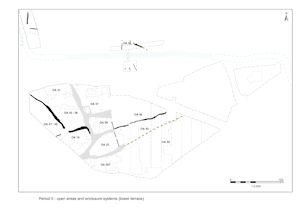
The Late Roman settlement continues to contract, and perhaps decline (Figure 177). The main thoroughfare of Roads 1 and 2 remains in use and receives a degree of maintenance early in Period 5 before showing signs of neglect and degeneration. Side Roads 3, 4 and 5 all pass out of use in Period 5 and signal the gradual fragmentation of the settlement infrastructure, particularly with more conspicuous encroachment by pits and buildings than has hitherto been the case.
Despite this perceived decline, the temple precinct (OA23) persists as a relative constant amid surrounding change. However, its front screening wall is removed by the mid-4th century, thus opening the enclosure and perhaps marking a change in the way the religious focus is regarded and used. Continued deposition of artefacts with likely ritual significance in pits along its northern boundary, and in a pit close to the temple cella doorway, confirms its continued religious function. However, no longer constrained by the precinct wall, such activity now seems to spill out into the open area in front (OA45). Further east, this same open space is encroached upon in the 4th century by at least one building and its associated fenced enclosures and pens.
Although adjacent and formerly closely associated, Open Areas 18 and 19 endure as tangible entities but the nature of their occupation and use becomes increasingly unclear. No new buildings and relatively few pits occupy their interiors, but their boundaries continue to be maintained and re-affirmed. While the previously suggested division of OA19 is now formally marked by a fence or wall that in essence extends the temple precinct wall northward, both enclosures experience deposition at their boundaries that may be ritual in nature and is probably associated with the temple. Of particular note is the deposition of a service of pewter vessels which, with one vessel bearing a Chi-Rho, gives the first hint of the presence of Christianity in the settlement.
Beyond this, the Southern and Northern Zones become less distinct as separate functional areas of the settlement. Indeed, no new buildings occupy the former and it seems to lose all vestiges of its occupation early in Period 5. The siting of a pottery kiln and crop-processing structures suggests this vicinity is becoming increasingly marginal and is now similar in nature to that part of the Period 4 Northern hinterland closest to the settlement. Similarly, the Northern Zone loses much of its divisions and lacks buildings west of Road 1. The paucity of pits of this date may suggest a change of depositional practice, with middening now being more prevalent. East of Road 1, roadside Building 54 is destroyed and removed and replaced by structures that are more centrally positioned within what remains of the landscape.
The field systems of the Northern hinterland also seemingly decline and fragment and there is little evidence of activity such as pit-digging within its marginal areas. The watercourse becomes more-or-less wholly silted up in the Late Roman period - perhaps as a consequence of the Period 4 wood-lined ditch/channel, which continues to be active and may divert water away from it. On the evidence of other investigations along Crescent Road, it seems likely that there is further Late Roman occupation on slightly higher ground to the north, beyond the Elms Farm development area.
Period 5 spans the late 3rd to mid-4th century AD. The late 2nd to mid-4th centuries (Periods 4 and 5) were divided into two to allow consideration and comparison of roughly proportionate spans of time. In addition Period 5 is marked by the apparent contraction and decline of the settlement. The issues of residuality and partial and fragmentary excavation need to be taken into account when considering the dating of any particularly feature. The identification of sub-phasing among the pits is particularly problematic and has generally not been attempted.
The Late Roman settlement continues to contract. While the main roads (Roads 1 and 2) remain in use and are maintained for a while, the side roads (Roads 3-5) all fall out of use (Figure 178). With the exception of the temple precinct area, there appears to have been a gradual fragmentation of the settlement infrastructure. In comparison with earlier periods the number of archaeologically tangible boundaries has reduced considerably.

The main north-south axis through the site, represented by Roads 1 and 2, remains in use, and receives at least some resurfacing, throughout Period 5. However, it is likely that 'side' Roads 3, 4 and 5 pass out of use as active thoroughfares. Even so, their lines continue to denote meaningful boundaries in this eastern part of the settlement.
The presence of 4th century pottery in the upper layers means that some Road 1 surfaces can be demonstrated to post-date the destruction of road frontage Building 54. Continued pitting on the line of Road 3 in Period 5 indicates that this road almost certainly no longer functions to the east of the temple precinct, although it remains possible that its approximate route is perpetuated as a trackway.
The northern part of Road 1 receives further surfacing (Groups 871, 872), although only one coherent metalling layer is apparent and other overlying layers are little more than patchy repairs or loose, silty gravels formed by the degradation of earlier road surfaces. Early 4th century pottery is present, though there is also a clear late 2nd to mid-3rd century element, presumably deriving from earlier surfaces as they disintegrate.
Within OA18, the western side of Road 1 is flanked by a 17m long ditch (Group 642), possibly cut in the later 3rd century AD and therefore contemporary with the continued use of the latest Period 4 road surfaces (Group 815). The ditch accumulates gravelly road-wash into the later 4th century AD, and contains an onyx intaglio (SF5109). Pit 13358 (Group 645) is cut just off its southern end.
At its northern end, silts generally accumulate on the eastern roadside during the 4th century and demonstrate soil formation over the increasingly derelict road. The eventual disuse of Road 1 can be dated to the second half of the 4th century by an accumulation of dark brown/black silts (Group 644) that develops on the western side of Road 1, close to its junction with Road 4. Together with gravelly road-wash (Group 839), these eventually seal the western Road 1 roadside ditch (Group 642 above).
There is little evidence for either the continuing use or indeed the abandonment of Road 2. Given that it almost certainly forms the main rote through the settlement together with Road 1, it is likely that it similarly functions into the 4th century.
Lacking any sign of upkeep in Period 5, but exhibiting encroachment by occasional pits (Groups 719, 882) both Roads 3 and 5 would seem to pass out of use as active thoroughfares. Possible slot-built Structure 51 (Group 876) is also cut into the final (Period 4) surface of Road 5.
In contrast, the Road 2/4 junction (Group 643) and the western part of Road 4 itself (Group 434) are perhaps repaired at this time and it seems likely that Road 4 remains in use until at least the start of the 4th century. One of these patchy repair deposits, layer 5499, contains an iron lynch pin (SF3206), presumably derived from the traffic using the road. Although Building 59 is unequivocally built on top of Road 4 (see OA45 below), the creation of irregular ditch 25260/25262/25077/25078 (Groups 466, 473, 584) along the northern roadside clearly indicates that, even if not an active thoroughfare during much of the 4th century, it endures as something of a boundary feature between OAs 23/45 and OAs 59/46.
While the temple precinct manages to retain its definition and identity, even with the loss of its front wall, the nature of the adjacent Central Zone plots, OA18 and 19 become somewhat vague. This said, some of the boundaries and distinctions between these component are retained and re-emphasised. The hitherto inferred division of eastern and western parts of OA19 are now formalised with the imposition of a fence or wall and these are relabelled OAs 59 and 46 for the purposes of description. Even though Road 4 clearly passes out of use as a thoroughfare, the creation of a ditch along its northern edge emphasises a real distinction between OAs 23/45 and 59/46. Some boundaries to the perimeter Central Zone are less well defined, although the re-affirmation of the northern boundary of OA18 demonstrates that the Central Zone - in essence what now constitutes the settlement proper - is still recognised and maintained.
The temple precinct survives as a distinct entity defined by what survives of Roads 2, 3 and 4 (Figure 180). Precinct wall Structure 46 continues to mark its eastern frontage, though its northern part subsides into Period 4 pit 22114 that had been dug too close to its footings. This necessitates underpinning works to the wall and consolidation of the offending pit (Group 439) in the late 3rd century. Despite this, the wall seems to collapse or is demolished by the end of the period, though firm evidence for its demise is confined to Period 6. While there is some replacement of the northern boundary alongside Roads 2 and 4 in the form of fenceline Structure 52 (Groups 421, 435) and its replacement ditch (Group 436), there is no corresponding Late Roman southern perimeter structure and it is presumed that the precinct is essentially open alongside the remnant of Road 3.
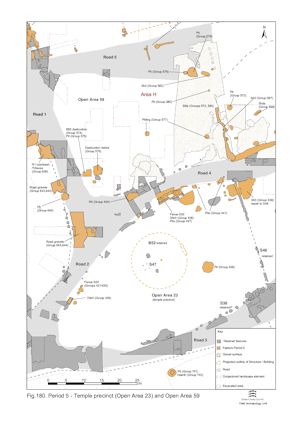
Although the circular temple Building 52 (Figure 148) remains standing throughout this Late Roman period, its continuation as a fully functioning building can only be presumed and there is no evidence to define the nature of use of its interior. While monumental post Structure 53 is also assumed to survive for the duration of Period 5, within the surrounding precinct the only new additions are pits. Most are positioned along the northern perimeter (Groups 437, 441), but earlier 4th century pit 5026 (Group 438) is conspicuously located just to the south of the temple doorway, somewhat reminiscent of the Period 3/Period 4 cluster to the north of the doorway. At least some of the deposition of artefacts within these pits is likely to have a religious/votive significance or association.
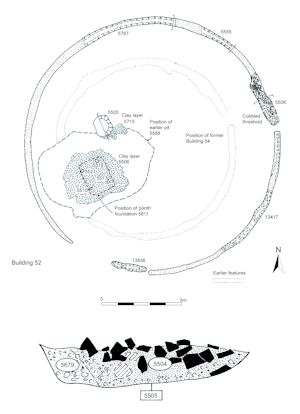
During Period 5, that part of Road/track 4 to the east of the temple precinct seems to fall out of use and OA45 perhaps now extends northwards across to include the line of the defunct road (Figure 181). However, the ditch line along the north side of the former road (25260 et al., Groups 466, 473, 584 above) continues to act as a boundary. It is more difficult to define where the southern boundary of OA45 lies at this time. The eastern part of Road/track 3 seems to have been falling progressively out of use from Period 3. Although the line of the former road is increasingly disrupted by pits (see Groups 699, 718) it is less clear whether or not the road completely ceases to mark a division in the landscape. There does, though, seem to remain a clear functional distinction between this gravelled area to the east of the temple precinct and the use of the land further south (OA50).
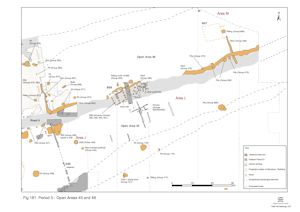
That part of OA45 directly in front (east) of the temple precinct is maintained as an open and surfaced space and retains its close association with the religious focus. Monumental post 21801 (Group 440) is erected in the late 3rd century, aligned on both the precinct wall and temple cella entrances. A coin (SF7694) of AD 273-4 and a mirror fragment (no SF) deposited within its pit may represent a foundation 'offering'. The presence of a well (22210 Group 448) can be inferred just to the north of the monumental post (Figure 182). Probably functioning as an active water source until the later 3rd century AD, its remains subsequently acquire a role as something of a votive pool, which probably begins in Period 5. The positioning of the post and of the well/pool would seem to be integral to the temple complex and may suggest that religious rites were not held exclusively within the confines of the precinct but extended onto the gravel-surfaced area to its east. The implication of this for the interpretation of religious practice is further explored elsewhere (Vol. 1, Chapter 6). The monumental post was removed in the early/mid-4th century.
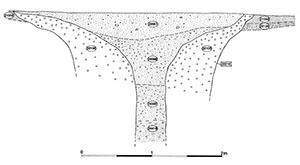
While signalling the disuse of Road/Track 3, large pits (15229, 15231 Group 699, 20193 Group 718) positioned on this southern edge of the eastern part of OA45 seem also to hint at deposition perhaps related to its religious usage. Containing personal items of jewellery and utensils, coins and substantial quantities of oyster shell, these pits are reminiscent of deposition within those in and around the temple precinct.
Although the eastern part of the OA45 interior may be preserved as open space in the earlier part of the Late Roman period, during the 4th century AD its use undergoes significant change. For the first time in its existence, buildings and associated structures are allowed to encroach. Building 59 (Groups 458, 459, 460, 461) is sited largely on the line of the former Road 4, clearly demonstrating its abandonment. Among the proliferation of post-holes at this location, a c. 6.5m square post-built structure can be discerned, with a probable eastward continuation/extension (Figure 183). Notably, this structure is positioned at a gap between the 'roadside' ditches 25077 and 25262 and would seem to be closely associated with the boundary.

Other concentrations of post-holes (undated Groups 5010-5015), while displaying less meaningful patterning, almost certainly represent additional structures or buildings further to the east of Building 59. To its south, a series of insubstantial slots and post-holes (Groups 462, 463, 464), supplemented by further un-numbered and unexcavated linear features recorded on pre-excavation plans, run orthogonally to Building 59. Collectively, these suggest that much of the OA45 interior, at least away from the temple precinct frontage, is now subdivided by fences into smaller enclosures. The common alignments of these features strongly suggest that Building 59 and the new fences are contemporary. The implication for much of OA45 is that the communal religious use of this space is diminishing and being replaced by increased occupation that includes encroachment by dwellings and associated gardens, paddocks, pens, enclosures, etc.
Evidence for Late Roman occupation within OA18 during Period 5 is both extremely slight and concentrated on its boundaries.
Along the western side of Road 1, shallow ditch 25247 (Group 642) and pit 13358 (Group 645) indicate the continuance of Road 1 and the need to delineate OA18 as a distinct entity, although both these features become filled with road-wash during the course of Period 5. Gradual neglect and perhaps dereliction of the road is evident as dark silt deposits built up along the roadsides and encroached over the road surfaces themselves.
Even more significant as an indicator of the survival of OA18 is the replacement of the boundary (fenceline Structure 42 and ditch 25015) along its north side, marking its boundary with the Northern Zone enclosure(s). Ditches 25027 (Group 838) and 25031 (Group 834) more-or-less perpetuate the boundary, though it is also inferred that the line of the west end of predecessor ditch 25015 continues to be marked in some way - perhaps by a hedge - so preserving the western boundary of OA18. Despite the absence of evidence for occupation within the enclosure, it is clear that domestic debris is finding its way into the ditches and it is likely that some form of occupation activity is nearby. However, the very large and diverse artefact assemblages from northern boundary ditch 25027, particularly adjacent to Road 1, indicate a probable ritual aspect to the deposition of some of this material. The presence of large quantities of 4th century coins, jewellery, other metalwork and face-flagon fragments suggests either votive deposition by visitors to the temple, or disposal of ritual-related debris from the temple itself. As such, it is difficult to assert that the removal of the monumental post (13433) from OA18 at the end of Period 4 represents the onset of a change to an exclusively non-religious use.
The previous west end of OA19 is now formally separated from the eastern part (OA46) by the creation of wall structure 44 (Group 567) (Figure 180). This possibly monumental wall is aligned on the adjacent temple precinct wall (S46) and extends between the remains of Roads 4 and 5. The wall post-dates late 3rd-early 4th century pits (Group 566) but is apparently robbed and sealed by silts (Groups 573, 583) before the end of the period. This OA23/28/59 'frontage' may in effect mark the eastern perimeter of the settlement core. It is possible that the creation of OA59 in fact represents a Late Roman northward extension of the temple precinct. However, it is also possible that Structure 44 represents a late manifestation of a pre-existing, and possibly long-standing, boundary and that the temple precinct had in fact been extended northwards at an earlier point in time.
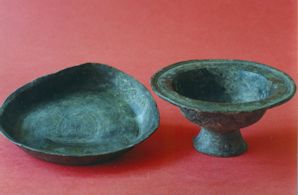
It is potentially significant that the northern end of Structure 44 coincides with the earlier widening of Road 5 as defined by the offset roadside ditches 25259 and 25115 on its south side (successively Groups 539 and 564 Period 4). This location, particularly given the apparent absence of a centrally positioned entrance in Structure 44, may well mark a point of access from Road 5 and OA46 into Open Area 59. More significantly still, this location is chosen to dig pit 6641 (Group 579) with its probable placed deposit of five pewter vessels (Figure 186). This collection of two plates and three bowls is overlain with the carcass of a headless horse and capped with tile. Most intriguingly, the underside of one of the bowls (SF3420) bears a scratched Chi-Rho symbol. Adjacent post-hole 6590 (Group 578) may constitute the erection of a marker post alongside this pit.
Within this seemingly newly defined enclosure, Period 4 Building 55 (Figure 152) may survive into the Late Roman period, although whether or not it is still habitable is unclear. The proliferation of rubbish within the building, sealed by its destruction debris (Groups 574, 576), hints that it may be abandoned in the late 3rd century prior to being destroyed by fire. External deposits of brown silt 6212 and 6228 (Group 574) - perhaps roadside accumulations - seem to build up against its walls, and may do so while it still stands. Whether the destruction and presumed clearance of Building 55 is part of an episode of change that accompanies the imposition of enclosure wall Structure 44 is unclear.

Within the remainder of OA59, other Late Roman activity is sparse and represented only by a low density pit distribution (Groups 575, 577, 580), and a scatter of uninterpreted slots/gullies (Group 568). Only pit 6149, perhaps deliberately positioned at the centre of OA59, is of note. Among other more mundane items, it contains a shale platter fragment (SF7723).
OA46, the former eastern portion of OA19, is regarded as retaining an association with OA59 despite its formal separation on the imposition of Structure 44, though this may lessen over time (Figure 187).
In the far east of the open area, Building 57 almost certainly passes out of use by the early 4th century and the enclosure interior is encroached upon by isolated 4th century pits (Groups 465, 566, 571, 572, 990), some of which (pits 20418, 20818) are located along the boundary ditch along the north side of Road 4 (see Road 4 above) and may in fact relate more to the occupation of Building 59 in OA45 rather than to activity within OA46 per se.
Gully 25079 (Group 469) offers the only vestige of identified subdivision of OA46, though does not extend particularly far across the interior away from Road/track 4. It is clearly short-lived and is post-dated by the imposition of road/trackside ditch 25260/25262/25077/25078.
By the mid-4th century Structure 44 is removed and it is assumed that OAs 46 and 59 revert to a single entity. The former line of this dividing fence/wall becomes covered by silty accumulations (Groups 573, 581, 583), which extend northwards over the line of Road 5 and south-east to overlie the route of the former Road 4 and the westernmost elements of ditch 25260 that perpetuate its northern edge. These deposits do not necessarily represent abandonment since patchy surfacings and sporadic activity (e.g. tile hearth 16181 Group 569 and isolated slot 6252 Group 582) interleave within them.
The disuse of Road 5 is clearly attested by the construction of slot-built Structure 51 (Group 876) and positioning of adjacent pit 7435 (Group 882) on its line.
With Building 39 already removed by the end of Period 4, it is entirely possible that OA28 has simply been incorporated into OA50 by the Late Roman period. Certainly, the range of activities - predominantly pitting and manufacture/processing - is consistent between the two. Lacking any sign of domestic occupation and now including dirty manufacturing processes such as pottery production, the increasingly marginal nature of this vicinity of the settlement is evident.
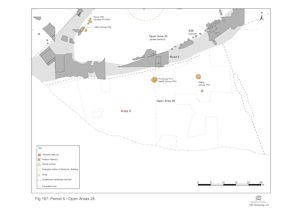
Activity is very sparsely represented within OA28, being restricted to a scatter of pits (Groups 741, 743) and a single hearth base 4378 (Group 742) set into the top of one of them (Figure 187). Pits 4429 and 14125, both relatively close to the temple precinct, are perhaps noteworthy for their oyster shell content.

Other than Kiln 14858, set on the western side of the enclosure, activity within OA50 is characterised by isolated and dispersed pits (Figure 188). Many of the more significant Period 4 features are redundant by the onset of Period 5. Well 14984 is backfilled early in the 4th century (Group 713); capping deposits within the well overlie a structured closure deposit of the carcasses of four dogs, a cow and young pigs. Even the east-west ditch 25177 (Group 668), that defines the abandonment of OAs 25-27, is short-lived and seems to pass out of use by the mid- to late 3rd century AD. Both Kilns 10906 and 11423 (Groups 672, 693) are abandoned by the late 3rd century AD, though the structures appear to survive in a ruinous state and to accumulate Late Roman rubbish within their chambers.
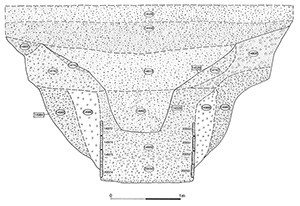
Late Roman pits (Groups 671, 675, 676, 698, 712, 717, 719, 984, 985) are relatively sparsely distributed across OA50, but contain relatively large and varied assemblages including domestic and personal items. The presence of litharge and an iron ingot may hint at continuing metalworking in the vicinity, with box fittings and a padlock component perhaps representing some of the items being fashioned. A strand of continuity from Period 4 pitting in this vicinity is evident. At the eastern end of OA50, the Period 5 pits (Group 675) cluster around ditch 25177, as was the case in Period 4 - perhaps indicating that, although the ditch was most probably infilled by this time, its line was still visible or perpetuated by a hedge. A possible hoard of ten coins dating to the AD 330s-40s is present within the top of pit 8555.
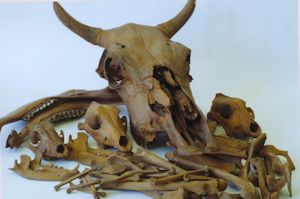
The Late Roman construction of Kiln 14858 (Group 714, Group 716) (Figure 189), in the western part of OA50, suggests that this now increasingly peripheral part of the settlement attracts dirtier production activities than hitherto. Disuse deposits within the kiln (Group 715) include spalled waster sherds that confirm the production of pottery at this location. A probable later 4th century drying floor (Group 721) lies close to the southern edge of now-defunct Road 3 and attests to the continuation of crop-processing here.
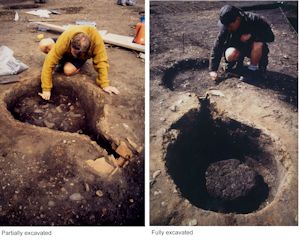
Although the major north-south ditch 25021 probably continues to provide some structure to the Northern Zone landscape west of Road 1, the detail of its subdivision is unclear. Probably by now somewhat simplified, it seems reasonable to describe activity within this vicinity of the settlement in terms of three basic units - OA31, OAs 32/49 and OAs 47/48 (Figure 191).
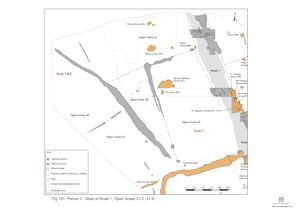
In the absence of any tangible evidence to the contrary, it is likely that the whole expanse bounded by Road 1, Road/track 5 and the watercourse is to all intents and purposes a single entity in the Late Roman period. This entity is now termed Open Area 57.
Despite the continued accumulation of 4th century material in the upper fills of ditches of Period 3C origin such as 25015 (Group 777) and 25021 (Group 776), it is perhaps likely that these major boundaries still function in Period 5, with Road 1 continuing to serve as another. No Late Roman activity is discernible to the west of ditch 25021 and the vast majority of the area to its east is also devoid of features. To what extent OAs 31, 32 and 49 survive as distinct entities is uncertain. Some pits do occur in Open Area 31 (Groups 836, 837, 989) and it is likely that this represents a real focus of activity, especially as Period 6 features also concentrate here. While all these pits have similar rubbish-rich finds assemblages, two distinctively square pits 8142 and 8155 contain human remains (Group 836), though this may be the result of an earlier burial having been disturbed (Figure 192).

If still present at all, OAs 32 and 49 are probably amalgamated by this time. The sparse pitting present (Groups 835, 842) seems to date to the first half of the 4th century AD. Pit 10763 includes a large corner fragment of a bonded brick structure (Figure 193) - perhaps deriving from a demolished building or more likely a lesser structure such as an oven or dryer.

A later 4th century midden (Group 841) occupies the northern part of OA32. Its presence may help explain the lack of late pits in this area, and suggests that the nature of rubbish disposal is changing during the later periods of occupation across the settlement, with middening replacing disposal in pits as the primary means of waste management. This has implications when considering decline and fragmentation of the settlement, as decreasing pit density cannot necessarily be taken for granted as a reliable indicator.
That part of the Northern Zone west of ditch 25021 (i.e. OA47/48) is devoid of Late Roman activity and is presumed to continue to function as a field.
The former system of subdivision of this part of the Northern Zone into OAs 33-36 is assumed to be abandoned by the Late Roman period and a single larger entity, OA57, takes their place. Former Building 54, sited at the Road 1/5 junction, burns down at the end of Period 4 and in the earlier part of Period 5 its site is cleared of debris - by the early 4th century at the latest - and silts accumulate over its site (Groups 865, 873). A widespread reorganisation of this part of the Northern Zone then follows. A new large rectangular Building 58 (Groups 878, 879) is constructed toward the centre of the plot, rather than at the road frontage as previously, and a system of ditches, gullies and fencelines (Groups 874, 875) is set out alongside. This system of likely trackways and sub-enclosures may extend eastward and northward up to the edge of the watercourse. Parallel gullies 25185 and 25186 (Group 971) just to the south of the watercourse, in Excavation Area R, could be a further eastward part of this system within OA57. Some Late Roman activity in this part of the settlement is attested by the continued accumulation of material in the slump hollow over infilled Period 3 Well 12245 (Group 955).
A second, admittedly somewhat tentative, Late Roman Building 60 (Group 880) constructed alongside the remnant of Road 5 may also be associated with Building 58. Related occupational evidence with either structure is, however, sparse. Few pits (Groups 877, 881, 884, 885) of Late Roman date are identified within OA57 and it is possible that either the focus for refuse disposal is elsewhere or that the nature of disposal practice has changed (as the midden dumps in OA32 may indicate). A small pit (Group 843), excavated in isolation alongside former Road/track 5, contains a hoard of seventy-three Late Roman coins, mainly barbarous radiates.
Within the Northern hinterland, no recorded features date to Period 5. It is possible that some of the cardinal features of the landscape - particularly north-south ditch 25187 - survive and Open Area 56 may also remain in use, but it is as ever difficult to discriminate between valid late re-cuts of ditch lines and the accumulation of later material in slump hollows over silted up ditches or possibly accumulating under the shelter of hedges perpetuating the boundary lines. Although it is virtually impossible to draw firm conclusions from the absence of evidence, one possibility is that the Northern hinterland is becoming more open and more pastoral in emphasis and that this may reflect wider changes in farming practice in the 4th century.
It is possible that some of the Period 4 boundary features, particularly north-south ditch 25187 and perhaps the ditches of sub-enclosure OA54 (25193/25194 etc.), survive for some time, as indicated by the continued accumulation of Late Roman material in their tops. However, no new Late Roman activity is apparent within the remnant landscape (Figure 197). Even pitting is absent.

It is therefore difficult to determine the nature and intensity of its use. While it may be reasonable to assume some or all of this part of the Northern hinterland continues to be agricultural land, is it now largely undivided pasture or even regenerated woodland? Fragments of some earlier enclosures probably survive within this. That defined by ditches 25187 and 25189 seem to endure long enough to be occupied in Period 6.
The absence of deposits within the watercourse that post-date the 3rd century suggests that by the 4th century it is more-or-less completely infilled and is now little more than a marshy strip along the foot of the upper terrace, perhaps flooding seasonally (Figure 198). On the north bank, boundary ditch 12027 is probably defunct, but the wood-lined ditch/channel 25271 remains in use into this Late Roman period and is probably actively maintained and cleared. It is tempting to speculate that it has diverted water away from the natural route of the watercourse and in doing so has contributed to its demise.
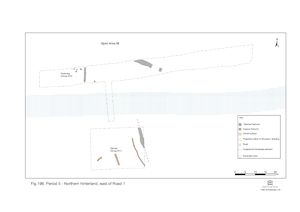
A small cluster of post-holes (Group 972) serves only to hint at unspecified further activity in this Late Roman period. However, this relative lack of signs of occupation may be a function of the marginal location of this vicinity. Excavations only a short distance to the north, along Crescent Road (Roy 2003; Wickenden 1986), have revealed a greater range of remains that indicate the upper terrace may be subdivided into a series of strip enclosures that back on to the terrace edge and remnant watercourse. Within these, pits and crop-processing structures and a well suggest they are perhaps occupied as smallholdings.
Internet Archaeology is an open access journal based in the Department of Archaeology, University of York. Except where otherwise noted, content from this work may be used under the terms of the Creative Commons Attribution 3.0 (CC BY) Unported licence, which permits unrestricted use, distribution, and reproduction in any medium, provided that attribution to the author(s), the title of the work, the Internet Archaeology journal and the relevant URL/DOI are given.
Terms and Conditions | Legal Statements | Privacy Policy | Cookies Policy | Citing Internet Archaeology
Internet Archaeology content is preserved for the long term with the Archaeology Data Service. Help sustain and support open access publication by donating to our Open Access Archaeology Fund.